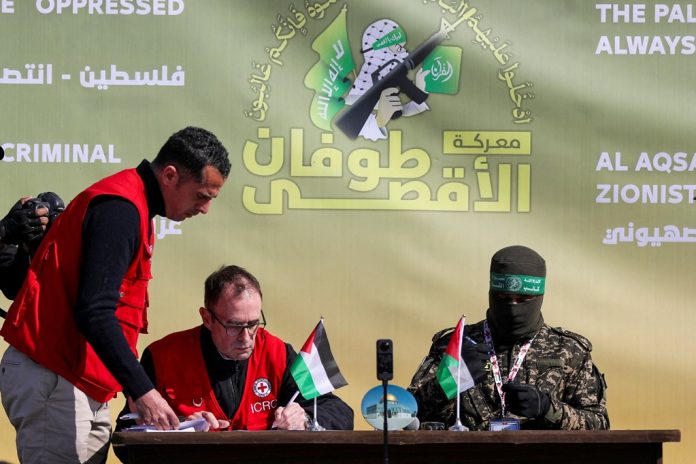Mirna Fahmy- Diplomatic Inside
After two previous attempts at a ceasefire in Gaza, the third one, which is under Trump, is being considered unattainable.
Since the Israeli-Hamas war that erupted after the October 7 attack, there have been ceasefire negotiations blowing hot and cold for 476 days (15 months), with no clear resolution in sight till Trump tuned in.
The 47th US president, Donald Trump, threatened Hamas in one of his conferences that “if the hostages aren’t back by the time he assumes office, hell will break out in the Middle East.”
After several negotiations off the cameras, a ceasefire deal was announced on January 16, 2025, between Israel and Hamas, aimed at halting hostilities that have resulted in extensive casualties with over 46,500 deaths and humanitarian crises in Gaza. The ceasefire began on January 19, 2025, a day before Trump’s inauguration.
The deal was held in Cairo, Egypt, including representatives of Egypt, Palestine, Qatar, the United States, and Israel to ensure effective coordination and follow-up on compliance with the terms of the Gaza Agreement.
This deal consists of three phases, releasing 1300 Palestinian prisoners in exchange for the remaining 33 Israeli hostages in six weeks. It also states the withdrawal from the Gaza Strip in these three stages and allows one million displaced persons to return to the north, as well as about 300 displaced individuals to return to Rafah. In addition to doubling the volume of humanitarian aid to the Gaza Strip and its regularity by American, Qatari, and Egyptian means.
Some of the Palestinian prisoners will return to the West Bank, per Israeli sources. Around 70 prisoners who are sentenced to death or forever in the Israeli prisons will be transferred through Egypt to one of the three countries; Türkiye, Tunis and Algeria as stated by the Egyptian news media Al-Qahera News.
Despite the ceasefire deal, Daniel Hagari, Israel Defense Forces (IDF) spokesperson, confirmed ongoing military operations in Gaza upon the announcement on January 16, citing Hamas’s failure to meet ceasefire conditions. “As of this morning, Hamas is not fulfilling its obligations and has not provided the names of hostages set for release.”
These strikes resulted in killing 81 and injuring 188 Palestinians.
On Jan 20, 2025, the Governor of North Sinai in Egypt, Khaled Mujawar, announced on his social platform that “the Egyptian will has succeeded, and Rafah city was opened in parallel with the ceasefire in Gaza and the beginning of the entry of aid and the continuation of development work in all sectors.”
Not only this, but also Egypt has opened the registration for doctors who wish to volunteer to treat the wounded and injured inside the Gaza Strip, the head of the Egyptian Doctors Syndicate, Osama Abdel-Hay, announced, noting that more than 2,000 are ready to volunteer and enter Gaza.
The deal has been welcomed with rage and opposition by many Jews and pro-Israelis, labelling this deal as “the worst,” committing another huge mistake. Their claim is that the Palestinians release will strengthen Hamas’ numbers, and more of the October 7 attack will happen regularly.
In 2011, Netanyahu released Yehya Al-Sinwar, a Hamas leader, and he was one of the masterminds behind the October 7 attack, killing over 1,700 Israelis. Sinwar was later killed by the IDF troops on October 16, 2024, in one of the buildings in Rafah town, in Gaza city. Mohammed Deif, a Hamas militant who was treated for cancer at one of the Israeli hospitals, took part in the attack, and he was killed by an IDF airstrike on July 13, 2024.
How many deals?
It is a third deal to be in effect after the previous two failed ones. The first one was on November 24, 2023—a four-day ceasefire, allowing for the release of hostages and humanitarian aid access. This ceasefire was later extended but ultimately ended on December 1, 2023, when hostilities resumed after failed negotiations for further extensions.
May 2024 Ceasefire was the second and the most awaited attempt to take place following months of conflict. A more comprehensive ceasefire was agreed upon on May 6, 2024, including a phased release of hostages and a gradual withdrawal of Israeli forces from Gaza over a period of 42 days. However, it didn’t happen, and the Rafah military operation kicked in, driven by many public opinions that if they agreed to a deal, more attacks would happen, and eliminating Hamas should be a priority to ensure Israel’s and the region’s safety.
What made Netanyahu agree?
The release of the hostages in exchange for the Palestinian prisoners has been in the ceasefire deal in the previous attempts. There were many furious regular protests from the hostages’ families to accept any deal that will bring out the hostages alive. All of this should have forced Netanyahu to take on the previous deals.
Agreeing to Trump’s deal has been described by the Hebrew media and analysts as “US pressure” on Netanyahu to accept it.
A source familiar with the ceasefire negotiations in Gaza told the Financial Times that the shift in Netanyahu’s position towards the deal and acceptance of it came because ending the war is a priority for Trump. Meanwhile, the Hebrew Channel 12 quoted an Israeli official as saying, “Trump recently began personally intervening in the issue of releasing the Israeli hostages and completing the deal.”
On Monday, January 13, 2025, Israeli and American media spoke of a “major breakthrough” in the negotiations, as Trump’s envoy to the Middle East, Steve Witkoff, exerted great pressure on Netanyahu, going as far as reprimanding him last Saturday and forcing him to meet him on Saturday (the Jewish holiday).
Unusually, the ended Biden administration allowed Witkoff to lead the process on the understanding that any commitments the United States made would be the responsibility of Trump, not Biden. Witkoff succeeded in forcing “Israel” to accept a plan that Netanyahu repeatedly rejected over the past half year, while Hamas did not back down from its conditions for the release of Palestinian prisoners and complete withdrawal from Gaza.
The Hebrew newspaper “Maariv” says, “This deal is excellent for Hamas and represents a dream that will be remembered for a long time in the movement’s history, as a complete victory over Israel.”
Indeed, Hamas’ fighters rushed in parades into the streets of Gaza with their weapons held up high, cheering for their victory. Neither pro nor con any side, there were opinions that say this isn’t a victory to be celebrated upon, as the entire city is under the rubble, requiring years and millions of dollars to be reconstructed again.
Maariv newspaper commented on what’s happening as the result of the explicit threats made by the US President, Trump, to Netanyahu. Netanyahu convinced himself to accept the broad guidelines proposed by Trump, which were the same ones that were presented to him last May and he rejected.
Though many Jews, Israelis, Zionists, and pro-Israelis were pleased with Trump’s win, thinking that Trump will back them up in their win against Hamas, a journalist close to Netanyahu said during a live interview on Hebrew Channel 14 on Monday evening, January 13, 2025, that “they are the first to pay the price for Trump’s election.” He added, “I don’t think this is what we planned and waited for. We expected that we would control northern Gaza and prevent humanitarian aid. This is a submissive deal. We submitted because of Trump and media pressure.”
Israeli Finance Minister Bezalel Smotrich stated that “the imminent agreement is tantamount to a disaster and surrender.” He urged “Israel” to “invade and cleanse the entire Strip and open the gates of hell on Gaza until Hamas surrenders and releases the hostages.”
Smotrich’s office told the “Israel Hayom” newspaper on Tuesday afternoon, January 14, 2025, that the minister and members of his party will decide within hours whether to issue an ultimatum to resign from the government if the deal is approved. Meanwhile, Israeli Channel 12 said that Smotrich is conducting extensive consultations with senior rabbis regarding the prisoner exchange deal and determining the position on it.
After his inauguration, Trump said to the press conference that he is not confident the’ Israel-Hamas’ ceasefire will hold till the second phase. “That’s not our war; it’s their war.”
Not believing a truce will be held between the sides, National Security Advisor Mike Waltz said, “If Hamas breaches this deal, we will back Israel 100% to go back to war; in the end, Hamas will no longer be in Gaza.”
The two famous Israeli politicians and journalists, Meir Masry and Edy Cohein, confirmed on their X accounts in Arabic that there is no deal and the war will intensify after six weeks.


